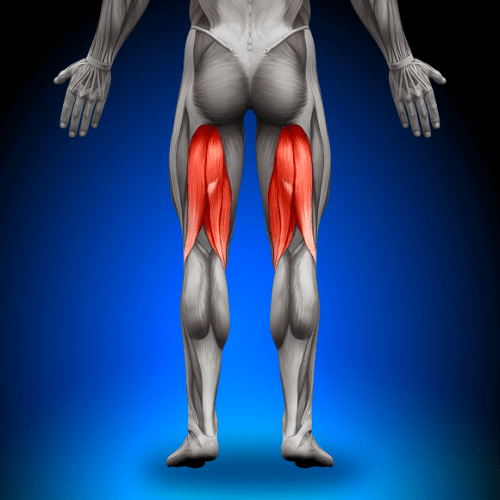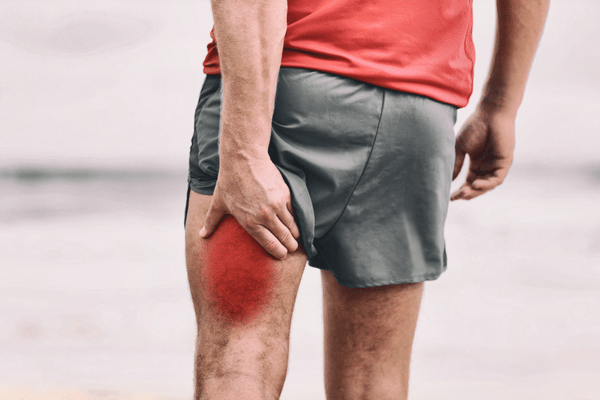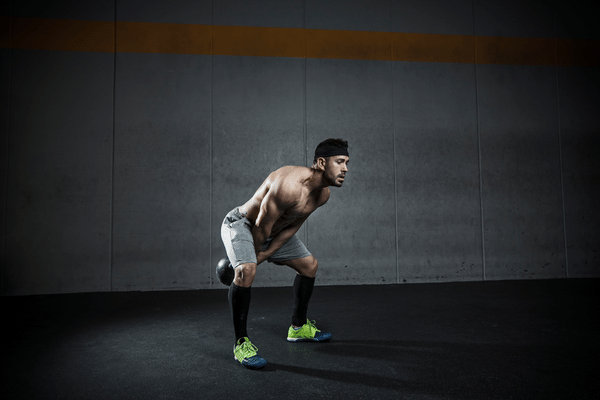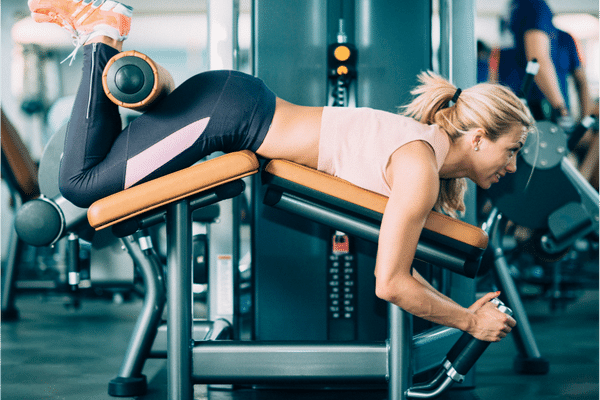Hamstrings are an incredibly important yet often overlooked muscle group when it comes to any form of strength and fitness training.
We use our hamstrings for day to day activities like walking up the stairs , running for the train or picking up the baby .
For those who actively play sport, strong and flexible hamstrings enhance athletic performance by allowing the body to move quicker, jump higher and change direction faster.
For functional fitness athletes, the hamstrings are crucial for supporting heavy lifts like the squat and deadlift and supporting all types of athletic movements.
The bottom line is WEAK HAMSTRINGS CAN IMPACT YOUR ATHLETIC PERFORMANCE AND PROGRESS IN THE GYM
This post uncovers the 5 best exercises for hamstrings but before we get into the detail, let’s take a look at the hamstring muscles and their functionality
What are Hamstrings?
The hamstring muscles are situated at the back of the upper thigh and are comprised of 3 muscles –
- Bicep Femoris
- Semimembranosus
- Semitendinosus
These muscles are a multi-functional and work in conjunction with the quadricep muscles to contribute to various movements, provide stability and support overall body function.
Primary Function of the Hamstrings
- Hip Extension – Hamstrings are responsible for hip extension which basically means the movement of the hip backwards. This is integral for movements like running, jumping and pushing away from the ground.

- Knee Flexion – This is effectively the bending of the knee joint and an absolutely essential movement for actions such as running, walking, jumping and lunging
- Knee Joint Stabilisation – Hamstrings work in tandem with the quadricep to stabilise the knee joint. The balance between the two muscle groups is essential to maintain knee alignment and avoid injury. This is particularly important for sports that involve quick changes of direction and abrupt stop/start movements.
- Deceleration – The hamstrings act as decelerators to control and slow down movement.
- Energy Transfer – The hamstrings are involved in the transfer of energy from the lower body to the upper body, this type of movement is common in actions like throwing
There is a tendency for training programs to focus on leg exercises that develop the quadricep which is the thigh muscle. This skewed focus can create an imbalance in strength between the front and back of the upper leg which can also increase the risk of injury and suboptimal performance.
The Benefits of Training Hamstrings
Training the hamstrings will no doubt be of significant importance for anyone who has weak hamstrings or mobility issues but also strength athletes looking to develop a stronger deadlift or squat may find that supplementary hamstring work will allow them to handle more weight.
Here we have selected 6 benefits which we think will be applicable to anyone with fitness aspirations.

- Enhanced Leg Strength – The hamstrings play an important role in leg strength and power. Strengthening the hamstrings will improve your ability to produce force in movements like squats and jumping and improve overall lower body stability
- Injury Prevention – Stronger hamstrings reduce the likelihood of incurring injuries. The hamstrings work in conjunction with the quadriceps to stabilise the knee joint. Imbalances between the two muscles can lead to strains or tears. Maintaining balance between quads and hamstrings will reduce the risk of injury.
- Lower Back – Weak hamstrings can often be the cause of lower back pain and posture issues. Strong hamstrings help to alleviate pressure on the lower back, improve spine alignment and overall posture.
- Functional Capacity – The hamstrings are involved in regular day to day activities like walking, bending and lifting. New parents with weak hamstrings find out very quickly how limiting weak hamstrings can be when caring for young children! Regular hamstring training will not only improve your ability to perform these relatively basically functions but also improve your mobility and quality of life!
- Athletic Performance – Strong hamstrings are essential for maximising your performance in a range of sports and physical activities. Any movements that involve running, jumping, turning and especially requiring explosive power will benefit from strong and developed hamstrings
- Aesthetic Appeal – Developed hamstrings provide shape and balance to the upper leg to give an athletically aesthetic appearance.
When to Train Hamstrings
As your hamstrings will be getting worked indirectly anyway through your non-specific training and everyday life, we only need to hit them with one targeted workout per week or if that is not practical, try adding add a few hamstring exercises to your existing allotted gym time.
I would suggest having at least a 48-hour gap between your hamstring training and any specific leg workout or if gym time is very limited then you could add hamstring exercises to your regular leg workout. If you do this and you have particularly weak hamstrings, I suggest putting your hamstring exercises at the beginning of the workout. Do this for 4 weeks to ensure that your hamstrings get specific attention rather than tagging onto the end of your regular legs workout when your legs will already be fatigued.
If your training style is more of a fully body workout, try adding 1-2 hamstring exercises to each session
The 5 Best Exercises for Hamstrings
A good hamstring workout will include specific hamstring isolation exercises that hit the muscle from diff angles and with a varied rep range. Research studies have shown that the Hamstring muscles respond well to both high and low rep training programs so combining both seems a sensible approach to structuring a Hamstring focused program.
1. Romanian Deadlifts (RDLs)
RDLs are probably the gold standard when it comes to combining isolation with progressive overload and will feature in just about any list of best exercises for hamstrings.
Basically, this is a deadlift variant which targets the hamstrings and glutes by adopting a straighter leg position (knees slightly bent), you should not feel any tension in the lower back.
You can perform RDLs with a Barbell or Kettlebell, you want to lower the weight by pushing your bum back and controlling the movement with your hip hinge keeping your legs and abs firm.
Lower the weight until you feel a stretch in your hamstrings and then come back up. Keep the weight close to the body throughout the movement to avoid placing any unwanted stress on the lower back.
As you become familiar and well-grounded with the movement, the aim is to lift some heavy weight here. Start with around 40% of your deadlift weight just to get the body used to the movement before building this up over future weeks.
Benefits of RDLs
- Strengthens hams and glutes = constant tension, the bar does not touch the ground
- Lighter weight than a Deadlift, train hip hinge with less overall stress to the body than conventional
- Greater Hip range of motion
- Improves performance in compound lifts like deadlifts and squats

2. Good Mornings
This is an excellent exercise for your hams, glutes, lower back and core but I would caution here that if you have a history of lower back issues or your hamstrings are particularly tight then really do start with a modest weight or just use the bar, to begin.
An alternative approach here is to use a dumbbell to perform conventional good mornings or to perform the movement in a seated position
An alternative approach here is to use a dumbbell to perform conventional good mornings or to perform the movement in a seated position
Benefits of Good Mornings
- Glute strength and hypertrophy
- Engages the entire posterior chain
3. Kettlebell Swings
Depending on your training style, KB swings may already be a familiar movement, this full-body functional exercise targets muscles along the posterior chain as well as your core and can also burn a load of calories in the process.
The kettlebell swing is a hip hinge movement and not a squat!
The movement itself uses the force of the hip hinge to thrust the kettlebell forward, as the bell then lowers back between your legs this is where you should feel the tension in your hamstrings.

This is one of the ‘easiest simplest hamstrings exercise to do at home given you literally just need one piece of equipment and operate with very limited floorspace
Benefits of Kettlebell Swings
- Trains hamstrings for strength, power, and endurance
- Improves hip extension
- Full body Conditioning
- Improves cardio and core stability
4. Nordic Hamstring Curl
This is an excellent movement for improving hypertrophy and uses your own body weight to engage all 3 hamstring muscles.
The eccentric strength of your hamstring is used to control the movement and prevent you from faceplanting the floor.
The movement itself involves kneeling (use a pad or matt for comfort) and lowering the body in a controlled fashion with ankles fixed in place, either by being held by a workout partner or secured under a Barbell or other fixed object (under the sofa if at home)
The movement should be slow and controlled, aim to get as low to the floor as possible before using your arms/hands to support you and then push yourself back to the starting position and go again.
If you find Nordics are just too challenging then try modifying by using a resistance band attached to a fixed object above your head when in the starting position. Pull the band so that each end can be held just in front of a shoulder so that as you lower the body the band assists the movement.

Benefits of Nordics
- Activates all 3 hamstring muscles
- Decreases risk of hamstring strains
- No specialist equipment needed
5. Lying Leg Curls
Lying leg curls are a great isolation exercise, if you do have tight hamstrings then you will really feel that with this movement.
The lying position provides a nice variation to the other 4 exercises listed but this is one where you really need to be in the gym using a specialised machine.
A workaround for those training at home is to lie face down on a bench and grip a dumbbell between your feet and curl the weight towards your hamstrings.

Benefits of Lying Leg Curls
- Isolates and strengthens the hamstrings
- Moves the hamstring through a full range of motion
- Improves flexibility
An Example Hamstring Workout
This workout should be performed once a week in addition to your regular leg training program.
As already stated, a typical strength training program will likely already include movements like the Squat and Deadlift which engage the hamstrings so we don’t need to go overboard with targeted training.
This workout consists of 3 sets per exercise and should be performed after thoroughly warming up the body and legs with some form of a dynamic warm-up. I would suggest the rower/bike for 10 mins .Once your body is warm I would suggest loosening the hamstrings with some targeted movements. One of the best hamstring stretches that I like to use is simply performing a good morning movement with no weight
| Exercise | Sets | Reps |
|---|---|---|
| Romanian Deadlifts | 3 | 10 |
| Good Mornings (Standing or Seated) | 3 | 10 |
| Kettlebell Swings | 3 | 10, 12, 15 |
| Nordics | 3 | 10 |
| Lying Leg Curls (dropset) | 3 | 12 |
Additional Information
To ensure that the hamstring muscles continue to get stronger we suggest a progressive overload approach to training. What this involves is continually increasing the intensity of your workouts to stimulate the muscles to keep improving strength, endurance and muscle size
In practice this means that if we are working in an 8-12 rep range and in week 1 we can just about manage 8 reps, in week 2 we would aim to hit a minimum of 9 reps (increased workload). Once 12 reps is achievable at the current weight then we increase the weight slightly (say 5%) , logically the number of reps we can now perform will drop to around 8-9 reps again and we repeat the cycle.
Just lifting the same weight for the same number of reps each week will likely produce gains in the short term and then a plateau so can be an effective approach if you have reached a desired outcome and are looking to maintain your current performance levels.
A combination of progressive overload / maintenance is a realist outcome for many of us over the long term.
If you dont have access to a gym but have some basic equipment you can perform hamstring exercises at home by focusing on RDLs, good mornings and kettlebell swings
Wrap-Up
For anyone looking to build strength and functional athleticism, the benefits of training the hamstrings are clearly evident. Moreover, ignoring your hamstrings will limit your overall progress in many of the popular compound lifts as well and increase the risk of injury.
A real world challenge for us all is always how we spend the limited time we have available to be in the gym. The workout included in this post has been designed to include the best exercises for hamstrings that can be added to an existing training program without being too time consuming.
Try to add these movements to either your existing leg day routine or schedule at least 48 hours apart from your regular lower body session. Start with light weights just to get a feel for the movements and gradually add weight over time.
In a relatively short time, you should start to feel the benefit of improvements in your form mobility and athleticism. Strength athletes should see improvements in squat and deadlift form as well as an ability to handle more weight and you may find your jeans are a little tighter around the thigh area!
If you are interested in reading about other ways to train legs, have a read of our post on The 5 Best Leg Machines in the Gym
Maximise your efforts in the gym by ensuring that your nutrition is on point with the free Absurd Fitness Nutrition Guide
0 Comments